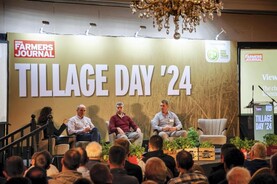According to Teagasc’s National Farm Survey 2017, only 21% of cattle-rearing farms are economically viable, with 28% of sheep and 32% of ‘cattle other’ family farms viable. These three farming systems account for over 70% of our 84,599 Irish farms, but 35% of all farms in the State earned less than €10,000 annually. The average family farm income for cattle-rearing was just €12,529, with 53% earning less than €10k annually. As a result, 31% of all farmers also work off-farm.
One of our guiding principles under the new CAP arrangements must be to achieve more economically sustainable income levels for our farmers.
Given the above Teagasc statistics, we must now look at the farming systems being encouraged by way of supports and refocus our efforts and deliver more for the rural economy and the environment.
Revenue from timber sales is direct market income that can contribute to bridging the gap between farmers’ incomes and incomes in the wider economy and will also help ensure the longer-term economic sustainability of the agriculture sector through reduced reliance on subsidies and through the generation of a more diverse income source for farm families.
The forestry sector also contributes €2.3bn to the national economy or roughly 1% of GDP. The sector employs 12,000 people and generates annual exports of over €350m. Importantly, the economic activity of the forest sector is spread through every region of the country and makes an important contribution to regional development and rural employment.
The Teagasc National Farm Survey figures consistently show that the income on cattle farms comes almost entirely from payments under the Common Agricultural Policy (CAP). Now, more than ever before, there is a need to improve farmers’ incomes and the new CAP proposals are a vehicle to achieve this aim.
This should be undertaken by building resilience in agriculture and forestry and by paying farmers for the public good benefits they provide from their land, whether this is climate change mitigation or other environmental benefits.
Such focused schemes can help address challenges such as climate change, habitat and species loss, water quality and increased flood risk. However, it should also have the objective to provide a new income stream for farmers, open to all and with payment for outcomes based upon the value to society and the State.
Three out of the nine specific CAP objectives concern the environment and climate change and there will be a mandatory climate change/environmental element of the CAP schemes post-2020. In fact, member states must spend at least 30% of the Pillar II budget on interventions directly targeted at environment and climate change and 40% of total CAP spending must be relevant to climate change.
Farming is a way of life, not just an income-generating activity, and is important socially and culturally in rural Ireland. The forestry sector must become more aware of this and look at other potential ongoing revenue opportunities from forests, where farmers can farm their woodlands generating ongoing income streams to allow families stay on the land.
This is now something that the forestry community is looking at and recent initiatives have shown that the sector is working to address this.
For example, recent Irish Timber Growers Association (ITGA) events have looked at different woodland enterprises from food to foliage production and the results are positive.
With over 10.3 million tourists visiting Ireland annually, spending €5.3bn, non wood benefits such as woodland recreation are becoming increasingly important and have potential for further development.
The forestry sector sees a valuable opportunity for greater integration of forestry with new CAP measures in order to achieve our FoodWise 2025 objectives, Ireland’s National Mitigation Plan, Project Ireland 2040 and other important national objectives.
Forestry is recognised as our most significant potential carbon sink and should be prioritised to assist landowners in addressing this requirement of CAP with appropriate payments to farmers for this public good.
It is essential that the new CAP regulations provide an appropriate framework for the inclusion of strong forestry elements in Ireland’s National Strategic Plan and the development of agricultural schemes under the CAP that contain attractive forestry options for farmers and landowners.
The forest sector is ready and able to make a major contribution to the continued growth of Ireland’s agri-business sector and full integration with CAP measures is the best way to achieve this.






 This is a subscriber-only article
This is a subscriber-only article











SHARING OPTIONS: